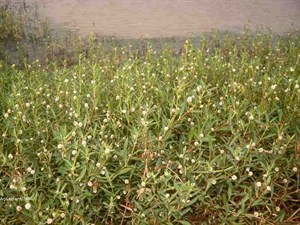Invasive - Eradicate!Alligator weed comes from South America and can grow in a variety of habitats, including dry land, but is usually found in water. It may form sprawling mats over the water or along shorelines making access difficult |

Problems
Alligator weed forms dense mats that crowd out native species and impede recreational activities such as boating, swimming, and fishing. Like the majority of aquatic invasive plants, alligator weed displaces native vegetation. Additional problems associated with alligator weed include decreased water flow and uptake for agricultural, municipal, and industrial purposes, and an increased expansion of human health risks with increases in mosquito breeding habitats.
Plant Description:
Alligator weed is a creeping vine-like plant whose stem may reach 4 feet in length. The leaves and ends of the stems are generally emergent but lower portions of the stem may be submerged, where they root extensively.
These stems are hollow, 1/4 inch or less wide and vary from dark green to pink or dull reddish-purple. The leaves of alligator weed are located opposite one another on the stem. Mature leaves are elongate, lance-shaped and may be up to one inch wide and four inches long. Those growing on stem ends are smaller and more elliptic in shape.
This plant produces a small, white flower, which closely resembles that of clover. These flowers are located on spikelets that arise from the leaf base. Alligator weed spreads by seed production and by fragmentation of the plant.
Hints to Identify
Alligator weed is generally distinguished from other plants by its combination of the following three features:
- small white papery flowers on short stalks
- leaves in opposite pairs
- hollow stems
|
Homeowner Treatment Options
|
| Shoreline Defense® Herbicide/Cygnet Plus Combo |
| Sonar AS |
| Sonar RTU |
| *Aquatic Biologists recommends implementing preventative management techniques and physical removal prior to, or in conjunction with treatment. |
Common Application Questions
Q. How much should I treat?
A. The entire population should be treated as alligatorweed is not native to the United States. Alligatorweed is listed as a weed of national significance
Q. When is the best time to treat?
A. Once water temperatures are around sixty degrees or warmer.
Q. How long before I see results?
A. It really depends on the product you choose. For most vegetation, control will take approximately 2 weeks however, tissue damage may be evident within 2 to 4 days with liquid formulations. Some products are slower acting with results taking 30 days or more to achieve. Re-treatments will most likely be needed.
